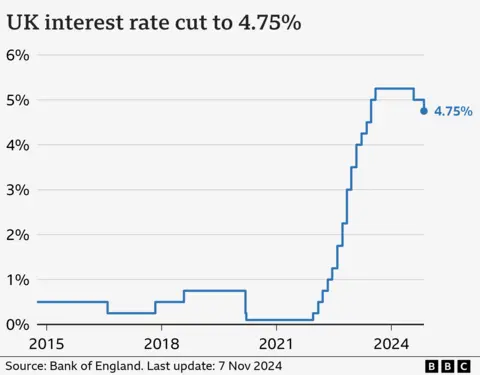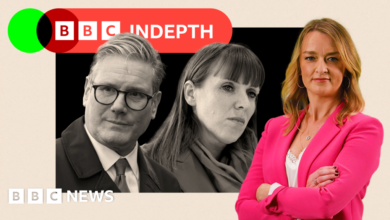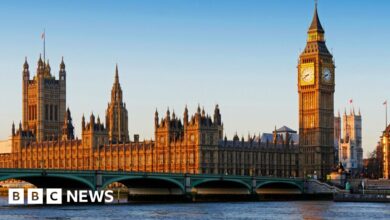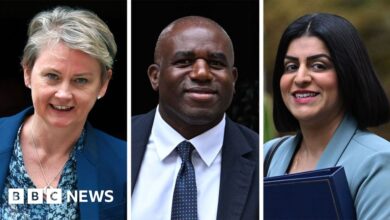UK interest rates cut to 4.75% but Bank hints fewer falls to come

 Getty Images
Getty ImagesUK interest rates could take longer to fall further after the Bank of England forecast that inflation will creep higher after last week’s Budget.
The Bank cut interest rates to 4.75% from 5% in a move that had been widely expected.
But it indicated that while the extra spending outlined in the Budget would initially boost growth, measures such as raising the cap on bus fares and VAT on private school fees would push prices up at a faster rate.
Bank governor Andrew Bailey said rates were likely to “continue to fall gradually from here”, but cautioned they could not be cut “too quickly or by too much”.
“The path is downward from here. We’ll see how quickly and by how much. I do emphasise the word gradual and the reason for that is there are a lot of risks out there in the world at large and also domestically,” he told the BBC.
Investors now do not expect any further rate cuts this year, with the Bank likely to hold rates at its next meeting in December.
Capital Economics economist Paul Dales said he now expected rates to fall slower to 3.5% in early 2026 rather than to 3%.
Inflation – which measures the pace of price rises – fell below the Bank’s 2% target in the year to September, but was always expected to rise again after gas and electricity prices rose last month.
It was then forecast to drop back to 2% by 2026, but the Bank now expects that to happen in the following year.
The Bank’s rate setting body – the Monetary Policy Committee – voted 8-1 in favour of the cut.
Catherine Mann voted to keep rates on hold citing the impact of the Budget on inflation as one of the reasons.
“The Bank of England has delivered one more cut for the road, before it’s widely expected to shut up shop for a while and wait for the dust to settle,” said Sarah Coles, head of personal finance at Hargreaves Lansdown.
“More borrowing in the Budget, a higher national living wage and rises in employer National Insurance contributions, have raised concerns that inflation could make an unwelcome return,” she added.
Given this, the Bank is “wary of cutting rates further”, Ms Coles said.
The slower pace of rate cuts “means better news for savers and those searching for an annuity, but bad news for mortgage borrowers”.
The Bank’s interest rate heavily influences the rates High Street banks and other money lenders charge customers for loans, as well as credit cards.
More than one million mortgage borrowers on tracker and variable deals are likely to see an immediate fall in their monthly repayments.
However, mortgage rates are still much higher than they have been for much of the past decade.
The average two-year fixed mortgage rate is 5.4%, according to financial information company Moneyfacts. A five-year deal has an average rate of 5.11%.
The latest rate cut means savers are likely see a reduction in the returns offered by banks and building societies. The current average rate for an easy access account is about 3% a year.
Chancellor Rachel Reeves, said: “Today’s interest rate cut will be welcome news for millions of families, but I am under no illusion about the scale of the challenge facing households after the previous government’s mini-budget.
“This government’s first Budget has set out how we are taking the long-term decisions to fix the foundations.”
Shadow chancellor Mel Stride said the rate cut would be welcomed by homeowners and “builds on the work the Conservatives did in office to hold inflation down”.
“However, the independent OBR and the Bank of England set out that as a result of Labour’s choices in the Budget last week inflation will be higher,” he added.
‘Rate cuts hit our savings’
 Claire Hopwood and Gavin Laking
Claire Hopwood and Gavin LakingClaire Hopwood and Gavin Laking have been consistently using their savings accounts while they get ready to buy their new house.
Gavin says it’s frustrating how quickly interest rate cuts can hit their savings.
“We’ve been enjoying a 4.5% rate on one of our accounts but that’s now dropped to 3.9%.”
Claire says the higher interest rates have been helpful: “It’s cover for emergencies. That’s all you can do, really.”

Last week’s Budget included plans to borrow an additional £28bn a year, as well as £40bn in tax-raising measures.
The biggest measure is an increase in National Insurance Contributions paid by employers.
Businesses are expected to pass on the cost of higher National Insurance costs to customers by raising prices.
It could also result in a slower pace of wage rises for employees.
The Bank also revised up its growth forecast for 2025 and suggested that the rate of unemployment could fall sharply to 4.1% from 4.7%.

What are my savings options?
- As a saver, you can shop around for the best account for you
- Loyalty often doesn’t pay, because old savings accounts have among the worst interest rates
- Savings products are offered by a range of providers, not just the big banks
- The best deal is not the same for everyone – it depends on your circumstances
- Higher interest rates are offered if you lock your money away for longer, but that will not suit everyone’s lifestyle
- Charities say it is important to try to keep some savings, however tight your budget, to help cover any unexpected costs
There is a guide to different savings accounts, and what to think about on the government-backed, independent MoneyHelper website.
What are interest rates? A quick guide.





